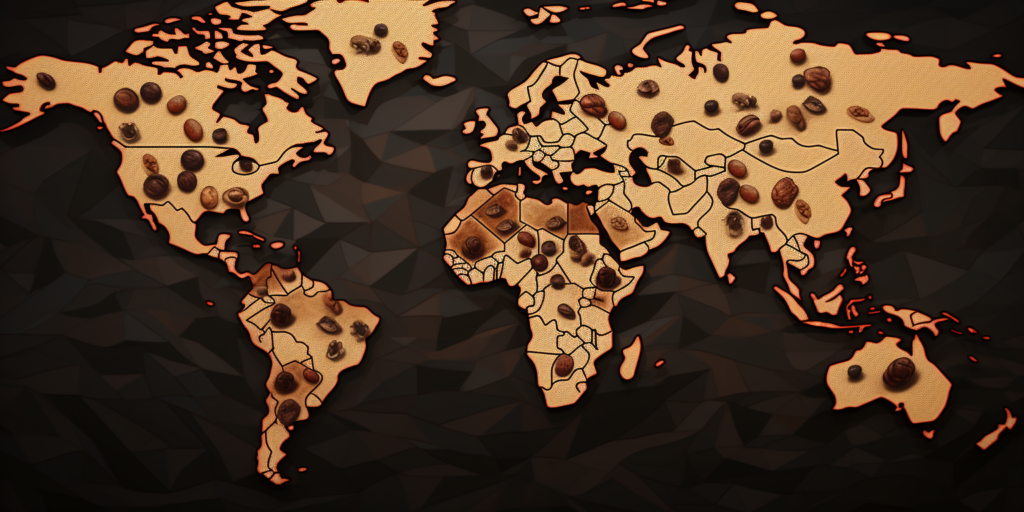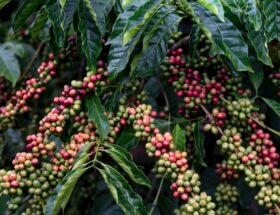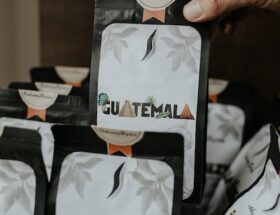
The Coffee Bean Belt: Its Importance Unveiled
Welcome to the world of coffee, where the aroma of freshly brewed beans fills the air and the rich flavors awaken our senses. Coffee is more than just a beverage; it’s a cultural phenomenon that brings people together from all corners of the globe. Have you ever wondered why some of the best coffees come from specific regions? Enter the Coffee Bean Belt, a fascinating concept that plays a crucial role in shaping the world of coffee as we know it.
In this blog post, we will explore the fascinating world of coffee and dive into the importance of the Coffee Bean Belt. We will uncover the hidden secrets behind this geographical region and shed light on why it plays a crucial role in producing some of the finest coffee beans in the world. So grab your favorite cup of joe and join us as we delve into the captivating world of coffee!
Coffee is one of the most popular beverages in the world, with millions of people enjoying its rich and diverse flavors every day. But where does coffee come from, and how did it become such a global phenomenon?
Table of Contents
Background Information
In this section, we will explore the origins and history of coffee, and how it spread across different regions and cultures.
- Coffee was first discovered in Ethiopia in the 9th century, where legend has it that a goat herder named Kaldi noticed that his goats became more energetic after eating some red berries from a bush. He tried the berries himself and felt the same effect. He then brought the berries to a nearby monastery, where the monks brewed them into a drink that helped them stay awake during prayers.
- Coffee soon became popular in the Arab world, where it was known as qahwah, meaning “wine of the bean”. Coffee was traded and consumed in places like Yemen, Egypt, Turkey, and Persia. Coffee houses emerged as social hubs where people gathered to drink coffee, chat, play games, and listen to music.
- Coffee was introduced to Europe in the 15th century, mainly through Venetian merchants who had contacts with the Ottoman Empire. Coffee was initially met with suspicion and resistance by some religious authorities, who considered it a “devil’s drink”. However, coffee eventually gained acceptance and popularity among the masses, especially after Pope Clement VIII declared it a “Christian beverage” in 1600.
- Coffee was brought to the Americas in the 17th century by European colonists and explorers. The first coffee plantation in the Americas was established in Martinique in 1720 by a French naval officer named Gabriel de Clieu, who smuggled a coffee seedling from Paris. Coffee cultivation soon spread to other parts of the Caribbean, Central America, and South America, creating a booming industry that transformed the economies and societies of these regions.
- Today, coffee is the second most traded commodity in the world, after oil. Its consumption continues to rise, with over 2 billion cups of coffee consumed every day. Coffee is grown in over 70 countries, mostly within the Coffee Bean Belt , which we will discuss in more detail in the next section.
Ideal Conditions for Coffee Growth
Coffee is a tropical plant that requires specific conditions to grow and produce high-quality beans. These conditions are mostly found within the Coffee Bean Belt , a geographic area that spans around 25 degrees north and south of the equator. In this section, we will explain how the climate, altitude, rainfall, and soil composition within the Coffee Bean Belt create optimal conditions for coffee plants to thrive.
- Climate: Coffee plants prefer a warm and humid climate, with temperatures ranging from 15°C to 24°C (59°F to 75°F). Extreme temperatures can damage or kill the plants, affecting their growth and yield. The Coffee Bean Belt provides a stable and moderate climate for coffee plants throughout the year.
- Altitude: Coffee plants grow best at high altitudes, ranging from 600 meters to 2000 meters (2000 feet to 6500 feet) above sea level. Higher altitudes provide cooler temperatures, which slow down the maturation process of the coffee cherries (the fruit that contains the coffee beans). This allows for more complex flavors and aromas to develop in the beans.
- Rainfall: Coffee plants need plenty of water to grow and produce beans. They require an average of 1500 mm to 2000 mm (60 inches to 80 inches) of rainfall per year, evenly distributed throughout the seasons. Too much or too little rainfall can affect the quality and quantity of the beans. The Coffee Bean Belt receives adequate and consistent rainfall for coffee cultivation.
- Soil composition: Coffee plants thrive in rich and fertile soils that are well-drained and slightly acidic. The soil should contain organic matter and minerals that nourish the plants and enhance their flavor. The Coffee Bean Belt has volcanic soils that are ideal for coffee growth.
Diversity of Coffee Flavors
One of the most fascinating aspects of coffee is its diversity of flavors. Depending on where it is grown, how it is processed, and how it is roasted, coffee can have different flavor profiles and aromas that appeal to different tastes and preferences. In this section, we will discuss how different regions within the Coffee Bean Belt produce different types of coffee beans with distinct flavor characteristics.
- Africa: Africa is considered the birthplace of coffee, as Ethiopia is where coffee was first discovered and cultivated. African coffees are known for their fruity, floral, and wine-like flavors, often with hints of citrus or berries. Some of the most famous African coffees are Ethiopian Yirgacheffe , Kenyan AA , and Tanzanian Peaberry.
- South America: South America is the largest coffee-producing region in the world, accounting for over 40% of the global coffee output. South American coffees are renowned for their balanced acidity, sweetness, and body, often with notes of chocolate, nuts, or caramel. Some of the most popular South American coffees are Colombian Supremo , Brazilian Santos , and Peruvian Chanchamayo.
- Central America: Central America is a region that produces high-quality coffees with a wide range of flavors and aromas. Central American coffees are typically smooth, clean, and bright, often with hints of fruit, spice, or honey. Some of the most notable Central American coffees are Costa Rican Tarrazu , Guatemalan Antigua , and Honduran Marcala.
- Asia: Asia is a region that produces robusta beans, which are more bitter, stronger, and higher in caffeine than arabica beans. Robusta beans are often used for espresso blends or instant coffee. However, some Asian countries also produce arabica beans that have unique and complex flavors, often with earthy, herbal, or spicy notes. Some of the most distinctive Asian coffees are Indonesian Sumatra , Vietnamese Da Lat , and Indian Monsoon Malabar.

Economic Impact of Coffee Production
Coffee production is not only a source of pleasure for coffee drinkers, but also a source of livelihood for millions of people within the Coffee Bean Belt. Coffee farming, processing, exporting, and trading provide income and employment opportunities for many small-scale farmers and local communities in these regions. In this section, we will analyze how the coffee industry contributes to the economy and society of Coffee Bean Belt countries.
- Income generation: Coffee production generates substantial income for Coffee Bean Belt countries, especially for those that depend heavily on coffee exports. For instance, coffee accounts for over 60% of Ethiopia’s export earnings , over 30% of Uganda’s export earnings , and over 10% of Brazil’s export earnings . Coffee income helps support the living standards and welfare of millions of people in these countries.
- Employment creation: Coffee production creates employment opportunities for millions of people within the Coffee Bean Belt, especially for rural populations that have limited access to other sources of income. For example, coffee employs over 25 million people in Brazil , over 15 million people in Ethiopia , and over 10 million people in Vietnam. Coffee employment helps reduce poverty and inequality in these regions.
- Social empowerment: Coffee production fosters social empowerment for many groups within the Coffee Bean Belt, especially for women and youth who often face discrimination and marginalization in their societies. For instance, coffee cooperatives and associations provide platforms for women and youth to participate in decision-making processes, access education and training opportunities, and improve their leadership skills. Coffee empowerment helps promote gender equality and social inclusion in these regions.
Environmental Conservation through Sustainable Farming
Coffee production can have both positive and negative impacts on the environment within the Coffee Bean Belt. On one hand, coffee farming can cause deforestation, soil erosion, water pollution, and biodiversity loss due to the use of pesticides and fertilizers. On the other hand, coffee farming can also support environmental conservation through sustainable farming practices that help preserve natural resources and protect ecosystems. In this section, we will explore how coffee farms in the Coffee Bean Belt adopt sustainable farming practices that help mitigate their environmental impact.
- Shade-grown coffee: Shade-grown coffee is a type of coffee farming that involves growing coffee plants under the shade of trees or other plants. This method mimics the natural habitat of coffee plants and provides benefits such as reducing soil erosion, conserving water resources, enhancing soil fertility, and supporting biodiversity. Shade-grown coffee farms serve as habitats for many species of birds, insects, mammals, and plants that would otherwise be threatened by deforestation. Shade-grown coffee also improves the quality and flavor of the coffee beans by allowing them to ripen slowly under optimal conditions.
- Organic coffee: Organic coffee is a type of coffee farming that involves growing coffee plants without the use of synthetic chemicals such as pesticides and fertilizers. This method reduces the environmental impact of coffee farming by preventing water contamination, soil degradation, and health risks for farmers and consumers. Organic coffee also preserves the natural flavor and aroma of the coffee beans by avoiding chemical residues.
- Fair trade coffee: Fair trade coffee is a type of coffee trading that involves ensuring fair prices and working conditions for coffee farmers and workers. This method promotes social and environmental responsibility by encouraging ethical practices such as paying living wages, providing safe workplaces, respecting labor rights, supporting community development projects, and implementing environmental standards. Fair trade coffee also empowers farmers to invest in sustainable farming practices such as organic or shade-grown methods.
Frequently Asked Questions about Coffee
1. What is the Coffee Bean Belt?
The Coffee Bean Belt is a geographic area that spans around the equator, known for its ideal climate for growing coffee. It includes countries such as Brazil, Colombia, Ethiopia, Vietnam, and many others. The name “Coffee Bean Belt” refers to the zone where coffee plants thrive due to the combination of temperature, rainfall, altitude, and soil conditions.
2. Why is the Coffee Bean Belt important?
The Coffee Bean Belt is important because it accounts for the majority of the world’s coffee production. The specific conditions within this belt create optimal growing conditions for coffee plants, resulting in high-quality beans. Coffee enthusiasts often seek out coffee from these regions for their unique flavor profiles and rich taste.
3. How does the Coffee Bean Belt affect the flavor of coffee?
The Coffee Bean Belt’s geographic location and climate have a significant impact on the flavor of coffee. Factors such as altitude, temperature, rainfall, and soil composition all contribute to the characteristics of the coffee beans. For instance, higher altitudes often result in beans with a more pronounced acidity and complexity.
4. Can coffee be grown outside of the Coffee Bean Belt?
While the Coffee Bean Belt is known for producing the majority of the world’s coffee, it is possible to grow coffee outside of this region. However, the flavor and quality of the beans may differ. Coffee plants require specific conditions to thrive, including the right combination of temperature, rainfall, and growing altitude.
5. How can I find coffee from the Coffee Bean Belt?
To find coffee from the Coffee Bean Belt, look for labels or descriptions that mention the origin or region where the coffee is grown. Specialty coffee shops and online retailers often provide information about the coffee’s source.
Summary
Throughout this blog post, we have uncovered the importance of the Coffee Bean Belt and its significant impact on the coffee industry. From the ideal climate conditions to the unique flavors produced, it is undeniable that this region plays a critical role in coffee production.
We explored the various countries that make up the Coffee Bean Belt and their distinct contributions to the world of coffee. Whether it’s the vibrant and fruity Ethiopian beans or the rich and balanced flavors of Colombian coffee, each country adds its own touch of excellence.
Moreover, we discussed the challenges faced by coffee farmers in this region, such as climate change and economic instability. It is crucial for us as coffee consumers to support sustainable and fair-trade practices to ensure the longevity of this vital industry.
Share your thoughts on the Coffee Bean Belt or let us know about your favorite coffee beans in the comments below. Let’s continue the conversation and celebrate the beauty and importance of coffee together!









